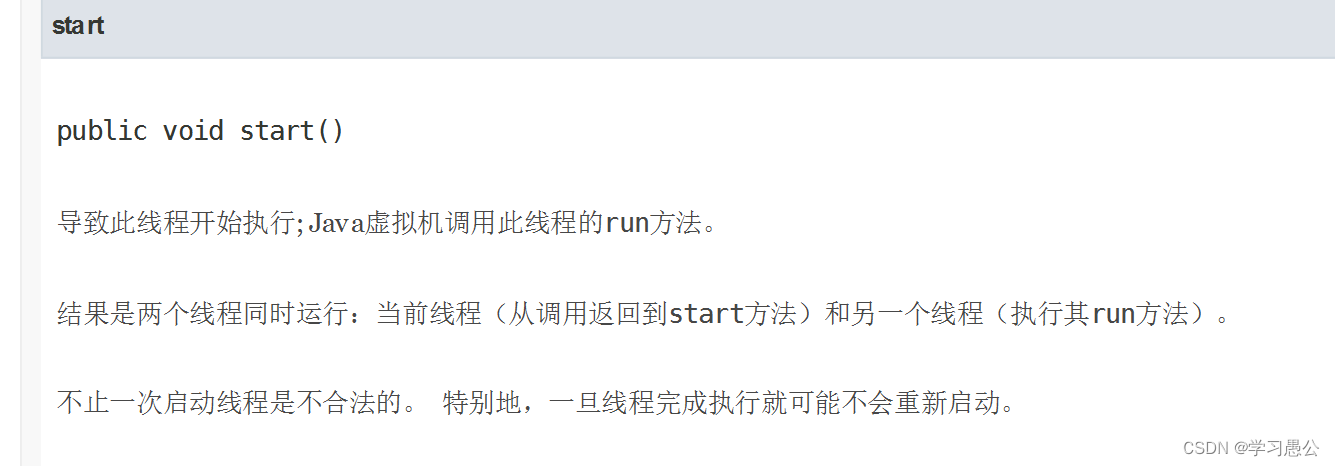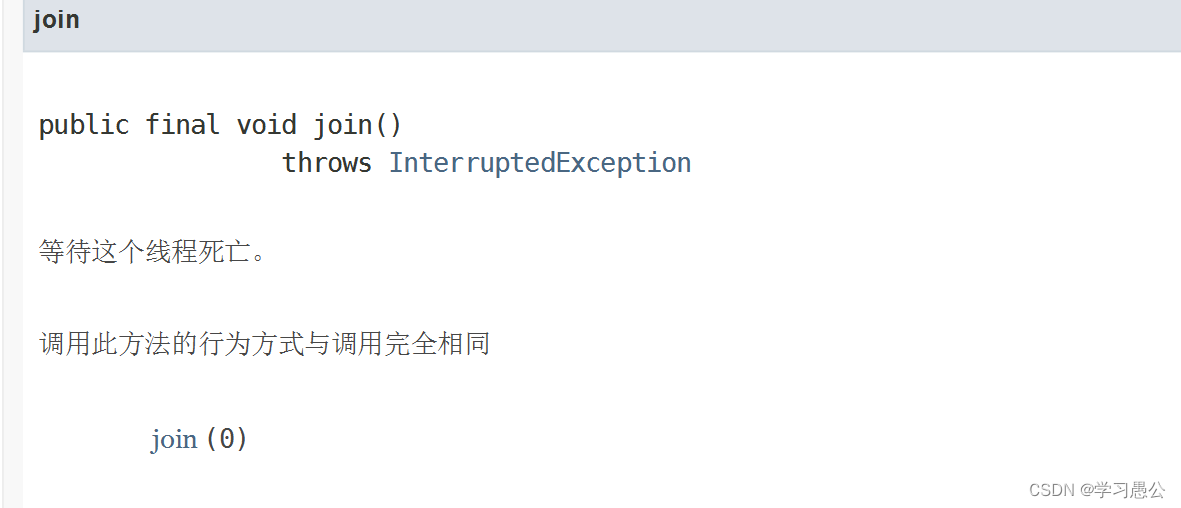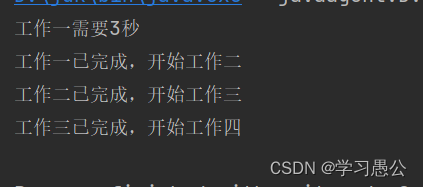文章目录
- 前言
- 一、run() 和 start() 方法
- 二、sleep() 方法
- 三、join() 方法
- 总结
前言
提示:若对Thread没有基本的了解,可以先阅读以下文章,同时部分的方法已经在如下两篇文章中介绍过了,本文不再重复介绍!!
-
【Java中Tread和Runnable创建新的线程的使用方法】
-
【Java中的Thread线程的七种属性的使用和分析】
提示:以下是本篇文章正文内容,下面案例可供参考
一、run() 和 start() 方法


代码示例 1
public class Ceshi {public static void main(String[] args) {Thread t = new Thread(new Runnable() {@Overridepublic void run() {System.out.println("hello world");}});t.run();System.out.println(t.isAlive());System.out.println(t.getState());}
}
输出结果

代码示例 2
public class Ceshi {public static void main(String[] args) {Thread t = new Thread(new Runnable() {@Overridepublic void run() {System.out.println("hello world");}});t.start();System.out.println(t.isAlive());System.out.println(t.getState());}
}
输出结果

由此看出:
- t.run()这条语句能够调用run()方法,但是没有启动线程,线程仍然处于NEW的状态,并没有启动线程,只是调用了一次run()方法。
- t.start()这条语句同样能够调用run()方法,但是它真正的启动了t线程,线程处于RUNNABLE的状态,然后t线程调用了run()方法
二、sleep() 方法

代码示例
public class Ceshi {public static void main(String[] args) throws InterruptedException {Thread t1 = new Thread(() -> {System.out.println("工作中");});t1.start();//该方法为静态方法,直接使用类名调用Thread.sleep(3000);//main线程休眠3秒后,才能继续执行下面的语句System.out.println();System.out.println("耗时三秒,工作完成");}
}
输出结果

结论
- 该方法写在那个线程里,就会使哪个线程休眠规定的时间,其他的线程不受影响。
- public static void sleep(long millis, int nanos)休眠millis毫秒后,再休眠nanos纳秒(范围:0-999999纳秒)
- 因为线程的调度是不可控的,所以这个方法只能保证实际休眠时间是大于等于参数设置的休眠时间的。
三、join() 方法

代码示例
public class Ceshi {public static void main(String[] args) throws InterruptedException {Thread t1 = new Thread(() -> {System.out.println("工作一需要3秒");try {Thread.sleep(4000);} catch (InterruptedException e) {throw new RuntimeException(e);}});Thread t2 = new Thread(() -> {System.out.println("工作一已完成,开始工作二");try {Thread.sleep(3000);} catch (InterruptedException e) {throw new RuntimeException(e);}});Thread t3 = new Thread(() -> {System.out.println("工作二已完成,开始工作三");try {Thread.sleep(2000);} catch (InterruptedException e) {throw new RuntimeException(e);}});Thread t4 = new Thread(() -> {System.out.println("工作三已完成,开始工作四");try {Thread.sleep(1000);} catch (InterruptedException e) {throw new RuntimeException(e);}});//在main线程中调用t.join(),就是让main线程等待t线程执行结束(保证t先结束)t1.start();t1.join();//t1的任务不结束,不会执行下面的语句t2.start();t2.join();//t2不结束,不继续进行t3.start();t3.join();//同理t4.start();t4.join();//同理}
}
输出结果

结论
- 有时,我们需要等待一个线程完成它的工作后,才能进行自己的下一步工作。该方法能够保证线程的任务有序执行,不会发生抢占式的进行。
- 同时还有带参数的重载方法,public void join(long millis) 等待线程结束,最多等millis毫秒,public void join(long millis, int nanos),在millis毫秒的基础上再加上nanos纳秒(范围:0-999999纳秒)
总结
除了以上常用的方法,还有许多的方法在前言中的文章已经详细介绍和使用,如若该文中没有找到你需要的,请跳转到前言的链接

![【Luogu】 P3665 [USACO17OPEN] Switch Grass P](http://pic.xiahunao.cn/【Luogu】 P3665 [USACO17OPEN] Switch Grass P)






---SG90舵机双轴云台模块)


![C++[第十七章]--模板引入](http://pic.xiahunao.cn/C++[第十七章]--模板引入)


)




